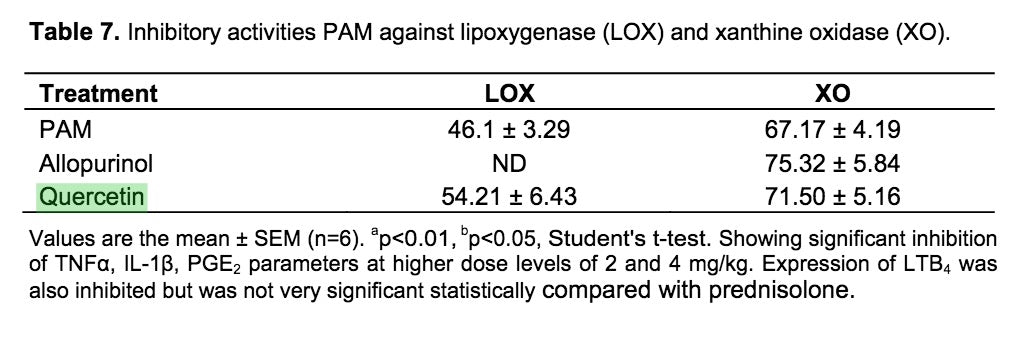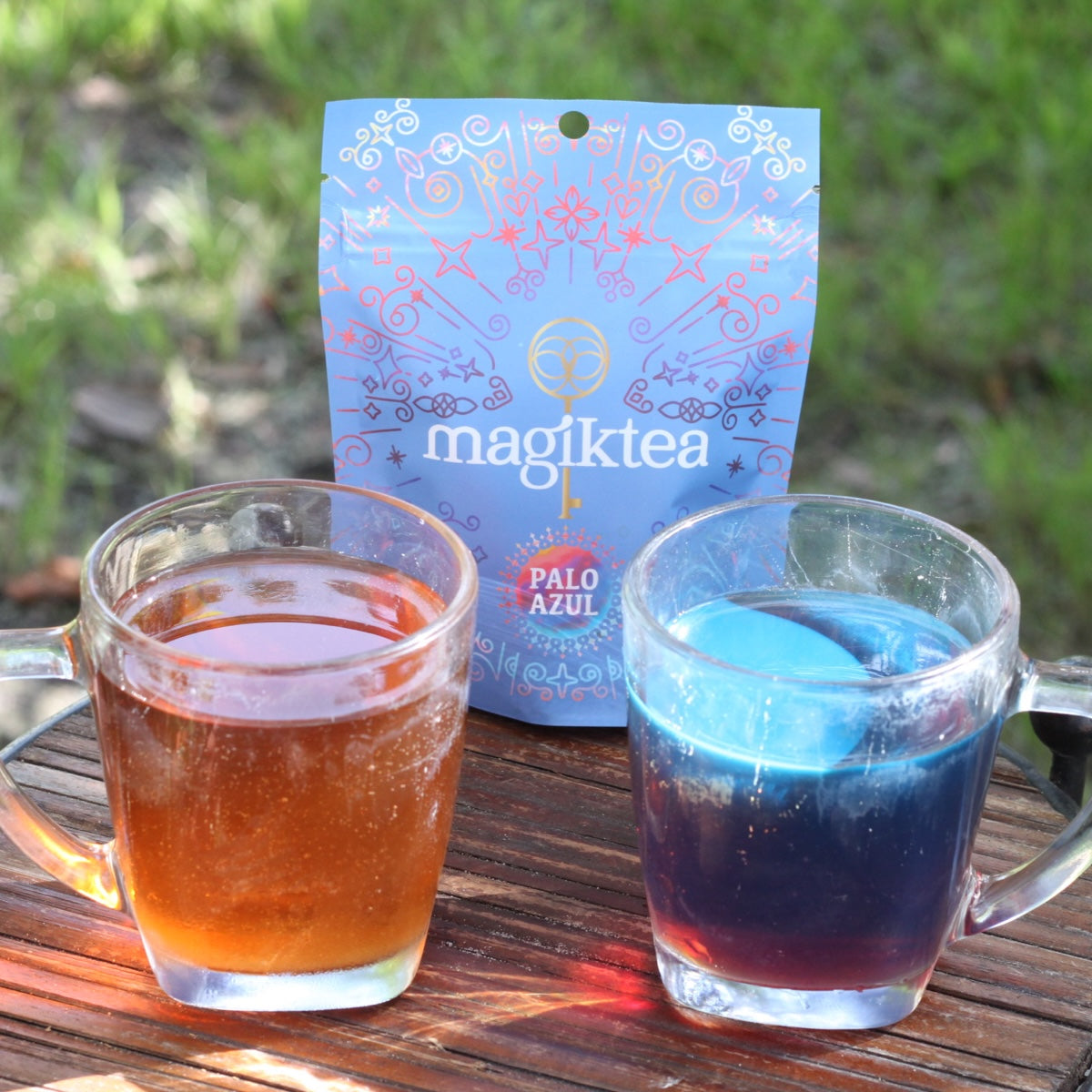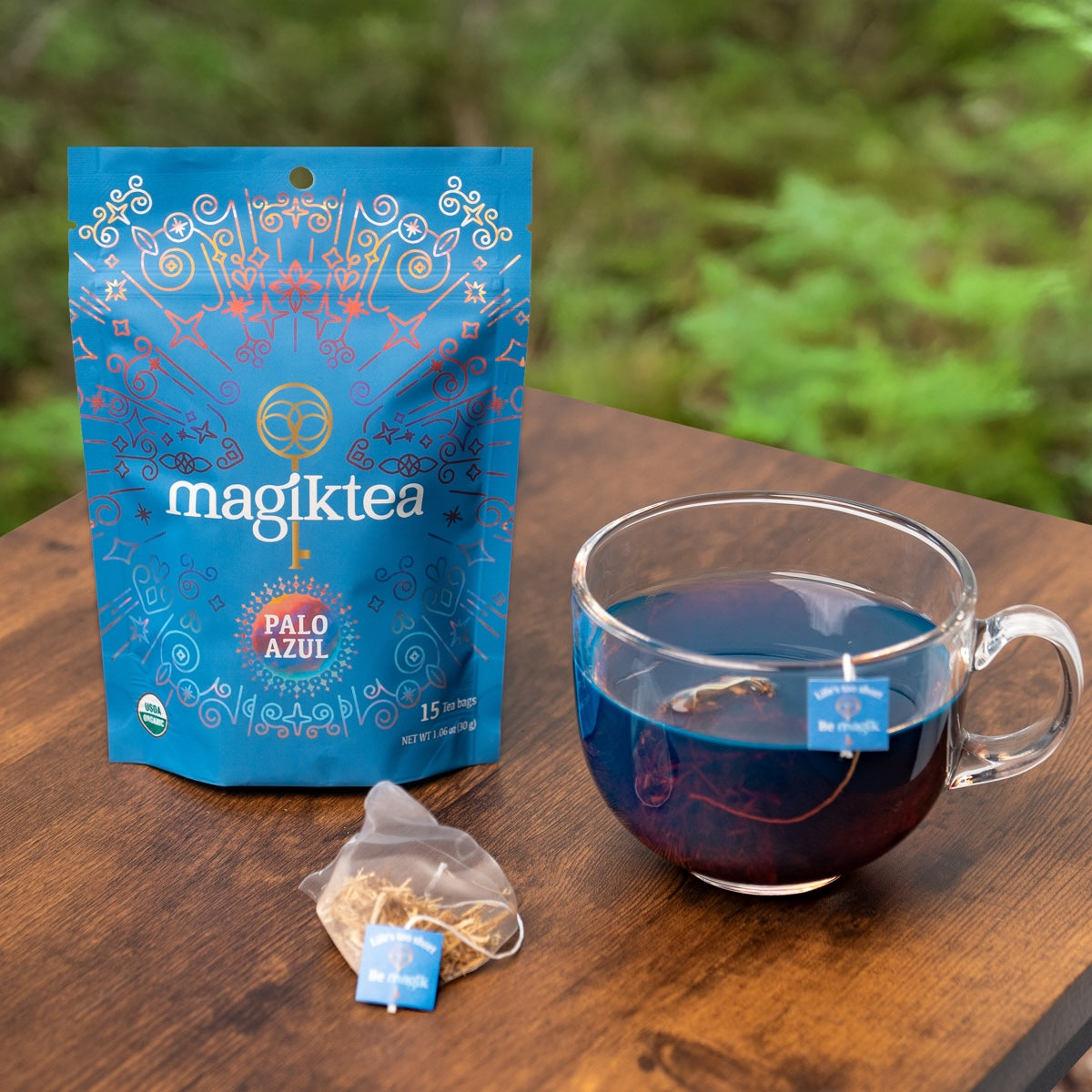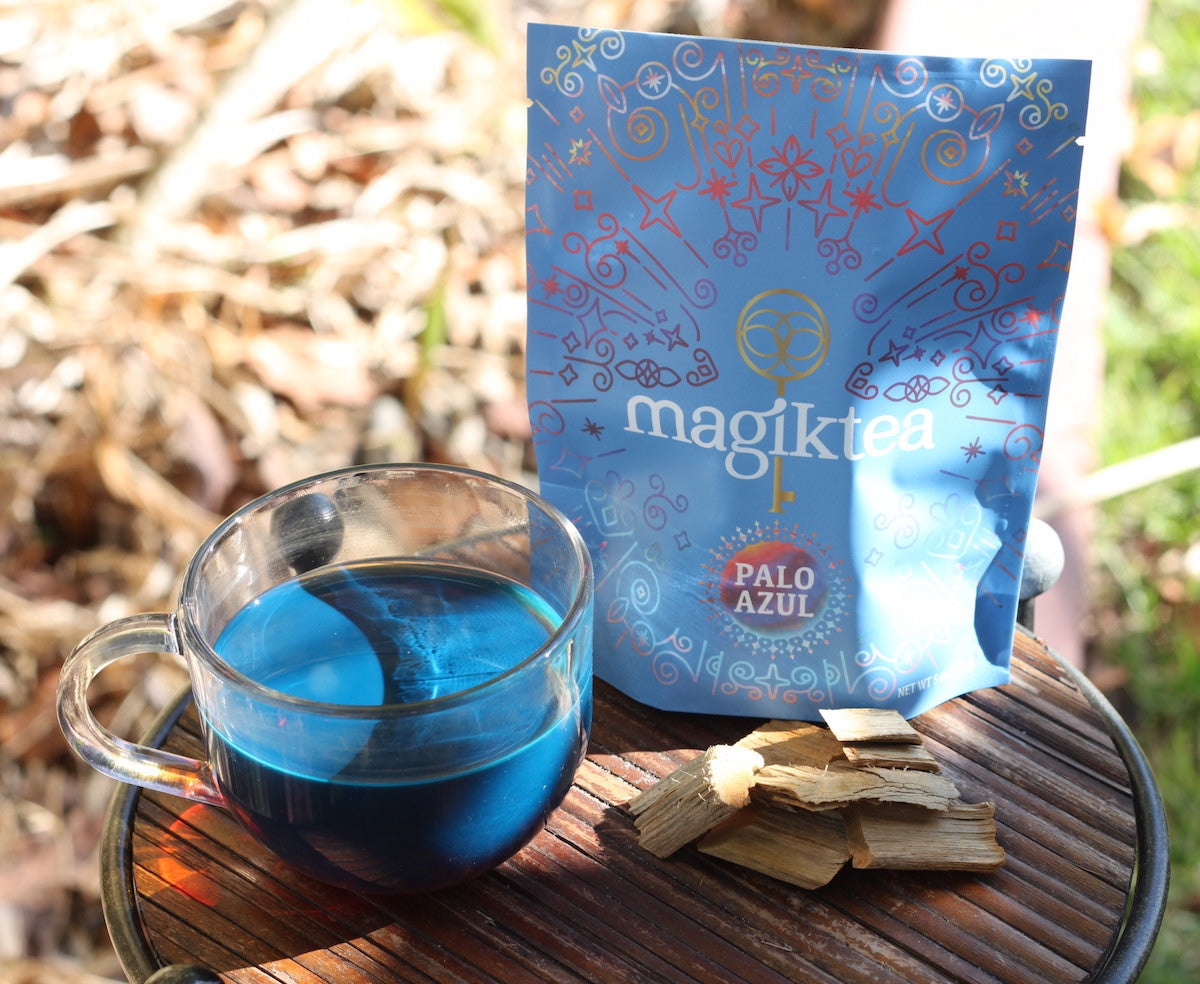According to several studies which tested the polyphenolic content and antioxidant capacity of palo azul and regular teas, palo azul showed around 8 times higher values. Some of the standard tests for measuring antioxidant capacity are the Folin-Ciocalteau TPC (Total Phenolic Content), ORAC (Oxygen Radical Absorption Capacity), DPPH, and TEAC. Fortunately, there are studies on the palo azul bark which have used all these methods to test its antioxidant capacity.
1.) Folin-Ciocalteau TPC (Total Phenolic Content)

TPC scores summary: Palo azul has around 2 to 8 times higher phenolic content than green, black, and yellow teas, and around 4 times higher than spirulina/algae.
- Palo azul = 856.5
- Yellow tea = 325-438
- Green tea = 106-430
- Black tea = 122-390
- Spirulina/algae = 192.8
- Moringa = 170.07
- Butterfly pea = 239
- Yerba mate = 132.5
The Folin–Ciocalteu (F-C) reaction is an antioxidant assay based on electron transfer, which measures the reductive capacity of an antioxidant. It has been widely applied in determination of the total phenol/polyphenol content of plant-derived food and biological samples.
This 2014 study found that palo azul’s total phenolic content was 856.50 ± 13.53 mg gallic acid / ml.
This study found that black tea, green tea, and white tea had total phenolic content of 122-390, 106-430, 325-438 mg gallic acid/mL, respectively. Another study tested 30 varieties of green, black, oolong, white, yellow and dark teas and their total phenolic content was 24.77 ± 2.02 to 252.65 ± 4.74 mg gallic acid / ml. This study found that black tea had total phenolic content of 99.8 mg-131.9 mg/g
The same study showed that yerba mate had a TPC of 120.4 mg-132.5 mg/g
This study found that spirulina platensis (blue-green algae) had a total phenolic content of 17-43.2 mg/g, and the algae with the highest phenolic content was Eisenia bicyclis, with a TPC of around 192.8 mg/g.
This study found that moringa had a TPC of 170.07 ± 0.43 mg /100 g gallic acid and another study found that moringa had a TPC of 88.05 ± 1.08 mg/g.
This study found that butterfly pea had a TPC of 185-239 mg/100g.
 The cool thing about palo azul tea, is that you can literally see the polyphenolic content, because studies show that palo azul's blue color is caused by fluorescent flavonoids (polyphenols). That's why palo azul looks blue when it absorbs light and it exhibits this incredible deep blue color which is an indication of the high polyphenolic content!
The cool thing about palo azul tea, is that you can literally see the polyphenolic content, because studies show that palo azul's blue color is caused by fluorescent flavonoids (polyphenols). That's why palo azul looks blue when it absorbs light and it exhibits this incredible deep blue color which is an indication of the high polyphenolic content!
2.) DPPH - IC50
 IC50 scores summary: *The lower the IC50, the higher the antioxidant activity. Palo azul had 8.7 to 26.5 times higher antioxidant capacity than green tea and black tea respectively, and it had around 20 times higher capacity than spirulina.
IC50 scores summary: *The lower the IC50, the higher the antioxidant activity. Palo azul had 8.7 to 26.5 times higher antioxidant capacity than green tea and black tea respectively, and it had around 20 times higher capacity than spirulina.
- Palo azul = 2.02
- Moringa = 8.06
- Butterfly pea = 11.97
- Matcha tea = 12.08
- Green tea = 17.62
- Black tea = 53.66
- Spirulina = 40.99
- Vitamin C = 53.24
This study explains what the DPPH test is: “The IC50 is the concentration of an antioxidant-containing substance required to scavenge 50% of the initial DPPH radicals. The lower the IC50 value, the more potent is the substance at scavenging DPPH and this implies a higher antioxidant activity.”
This 2014 study concluded the following about palo azul: “The result showed that EP (palo azul) possesses a moderate scavenging activity with IC50 = 2.02 ± 0.98 μg/ml.” Moreover, the researchers found that the “free radical scavenging activity of EP showed 98.32% and ascorbic acid (vitamin C) 86.53% at the same concentrations.”

For reference, this study showed that vitamin C (ascorbic acid) had an IC50 of 53.24±0.82
This study found that black tea and green tea had an IC50 of 53.66±4.57, and 17.62±1.76 respectively.
This study found that moringa had an IC50 of 8.06 ± 0.29 μg/ml.
This study found that butterfly pea had an IC50 of 11.97±0.38a.
This study on matcha tea found that it had DPPH IC50 scavenging levels of 12.08 to 23.48. Another study showed that matcha tea had a DPPH IC50 value of 28.74 ± 1.57.
This study about spirulina found that its antioxidative peptides "exhibited high antioxidant activity at IC50 40.99 µg/mL."
Why is palo azul’s antioxidant capacity so much higher than regular tea?

According to these numbers, this would imply that palo azul’s antioxidant capacity was 8.7 to 26.5 times higher than green tea and black tea respectively!
This study explains why processed tea leaves have a lower DPPH and total phenolic content:
“As with DPPH Radical Scavenging Activity, the IC50 value and total polyphenol also decreased with each processing step of green tea and black tea. The decrease can be caused by oxidation, such as in the OTR (open top roller) machine. The wet sorting process also slightly decreases the antioxidant content of tea because in this process the sifted tea shoots have more contact with air in the presence of particles that are already small in size.”
Therefore, the researchers concluded that “processing reduces the DPPH Radical Scavenging Activity value, IC50 value, total polyphenols and catechin and EGCG values of green tea and black tea.”
3.) TEAC - ABTS

TEAC scores summary:
- Palo azul = 98.34%
- Spirulina = 90%
- Green tea = 78.2%
- BHT = 99.42%
The TEAC measures the antioxidants capacity to scavenge free radicals (ABTS) in comparison to Trolox, which is a synthetic vitamin E.
This study explains exactly what the TEAC test is: “The trolox equivalent antioxidant capacity (TEAC) assay was first developed as a simple and convenient method for total antioxidant capacity (TAC) determination. The assay measures the ability of antioxidants to scavenge the stable radical cation ABTS (2,2′-azinobis(3-ethylbenzothiazoline-6-sulfonic acid)). Antioxidants can neutralize the radical cation, generated from ABTS, by either direct reduction via electron donation or by radical quenching via hydrogen atom donation.”
This study explains that the “TEAC reflects the ability of antioxidants to scavenge the ABTS radical-cation compared with Trolox."
Trolox is a water-soluble analog of vitamin E. It is an antioxidant like vitamin E and it is used in biological or biochemical applications to reduce oxidative stress or damage.
This 2014 study found that “the percentage inhibition was 98.34% for the extract (palo azul) and 99.42% for BHT at 0.1 mg/ml concentration. From the results obtained, it is anticipated that EP is a more efficient scavenger than standard ascorbic acid.” The researchers mention that “the methanol/water extract of EP was fast and effective scavengers of the ABTS radical and this activity was comparable to that of BHT.”
Butylated hydroxytoluene (BHT) is a most commonly used antioxidant recognized as safe for use in foods containing fats, pharmaceuticals, petroleum products, rubber and oil industries.
This study on green tea concluded that "the %-inhibition (78.2%) of a 24-h-aged, 2.5-g-sample of tea brewed at 4 °C is approximately 40% higher than that (55.5%) of 1-h-aged green tea."
This study showed that spirulina platensis had a DPPH radical inhibition of 90%.
4.) ORAC (Oxygen radical absorbent capacity)

ORAC score summary:
- Palo azul = 74.28%
- Quercetin = 70.45%
- Trolox = 64.12%
This 2014 study explains that ORAC is a method used to measure the scavenging activity of peroxyl radicals. The same study concluded the following about palo azul: “The results showed EP with the ORAC + value of 6.12 ± 1.28 μmol α-tocopherol.”

The study also found that “a 50 μg/ml solution of EP and quercetin exhibited 74% and 70.45% inhibition, respectively. NO (nitrous oxide) scavenging capacity of extract was higher than that of quercetin. The EP observed value indicates that the bark extract is a better hydroxyl radical scavenger than the standards BHT, Trolox and mannitol with values of 74.28, 73.59, 64.12 and 69.67%, respectively.”
Moreover, they showed that “EP had a superoxide radical scavenging activity (62.19% inhibition), which was greater than that of reference antioxidant (52.97% inhibition) at the same concentrations (P < 0.05).”
Other

The researchers from the previously cited 2014 study concluded that “the ORAC, ABTS and DPPH values indicated that EP possesses significant radical quenching properties. EP has the best antioxidants of ascorbic acid and BHT, suggesting that EP is able to chelate metals.”
This 2015 study found that “PAM (palo azul) possesses strong activity in XO (xanthine oxidase) and LOX (lipoxygenase) enzyme inhibition compared to that produced by allopurinol and quercetin.”

Xanthine oxidase (XO) is a form of xanthine oxidoreductase, a type of enzyme that generates reactive oxygen species.
Allopurinol is in a class of medications called xanthine oxidase inhibitors.
Conclusion
From the studies we reviewed here, it appears that palo azul has a considerably higher amount of polyphenols and antioxidant capacity in comparison to other compounds such as green tea, black tea, spirulina, yerba mate, quercetin, and vitamin C. So now you know, when you see palo azul's blue color...that's an indication of its polyphenolic rich content and that's what gives it its powerful antioxidant capacity!
Studies
Palo azul is commonly referred to by its scientific name Eysenhardtia polystachya, Cyclolepis genistoides, lignum nephricitum, kidneywood, kidney tea, or palo dulce.
(2017) Folin–Ciocalteu method for the measurement of total phenolic content and antioxidant capacity
(2018) Modeling of Total Phenolic contents in Various Tea samples by Experimental Design Methods
(2015) Phenolic Content and Antioxidant Capacity in Algal Food Products
(2018) Antioxidant Activity of Methanol Extract from Several Indonesian Green Teas
Trolox Equivalent Antioxidant Capacity
(2021) Effect of Brewing Temperature on the Total Antioxidant Capacity of Green Tea
(2018) Antioxidant Activity of Different Forms of Green Tea: Loose Leaf, Bagged and Matcha
(2020) Antioxidant Properties and Nutritional Composition of Matcha Green Tea








